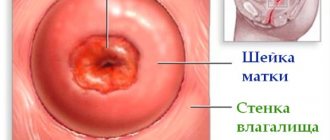Every second woman is diagnosed with cervical erosion. After conducting the necessary research, the gynecologist determines the treatment method. The rehabilitation process depends on which method is chosen.
Cauterization of cervical erosion is performed with electric current, liquid nitrogen and surgitron (radio waves). After the damaged cells are destroyed, the healing process begins, often accompanied by discharge of various colors and patterns.
We will discuss below in the article what kind of discharge occurs after cauterization of cervical erosion.
Erosion and its treatment
The cervix is covered with a layer of cells that function normally provided there is no abnormality or injury. External or internal factors can provoke changes in cellular structures, which leads to erosion (read more), which requires timely treatment.
After the diagnosis is confirmed, a procedure is performed to remove pathological cells - cauterization of the erosion with liquid nitrogen, current or radio waves. As a result of this effect, the external cervical os begins to bleed, and the woman notices unusual discharge that was not there before.
Some of them are a normal healing process, but others may occur, symbolizing that pathological changes are occurring in the woman’s body.
The duration and nature of the secretions released depends on the method of cauterization:
- Radio waves – brown discharge may bother you during the day.
- Electric current is a traumatic method that provokes blood secretion, which lasts about 3 days.
- Coagulation most often does not cause any changes.
- Laser – blood is observed in the discharge for about two days.
- Cryodestruction - a brown, spotting secretion appears.
Changes occur due to the involvement of blood vessels in the process of treating erosion.
Symptoms
Wound healing occurs within 1-2 weeks, in some cases it may take a month. To understand whether the wound is healing or not, you need to monitor the nature of the discharge, its color and smell.
Normal manifestations include the following discharge:
- Brown - thick, scanty secretion, which disappears in 8-10 days;
- Transparent, white and watery - appear faintly, sometimes containing blood clots. Secretion is disturbing in the first week, over time the consistency becomes viscous and the intensity increases;
- Red, bloody and pink in color - stand out in the first 9-14 days, the density and quantity gradually increases. After healing, secretion becomes normal.
The list shows normal discharge, but if a woman feels a strong unpleasant odor, then the process is not going well, and most likely the affected area has become infected.
Healing may be accompanied by mild pain in the lower abdomen, which does not cause much discomfort. After the scab falls off, bloody secretion may appear. Usually they disappear after a couple of hours; if this does not happen, it is better to consult a gynecologist.
Severe weakness, elevated body temperature, intense bleeding, and dizziness are considered a dangerous signal.
Contraindications
After cauterization, the healing process must not be disrupted. A scab is comparable to a surgical suture, which can come apart if you do the wrong thing.
During the first month, a woman should exclude:
- Vaginal sex.
- Wearing sanitary tampons.
- Lifting heavy weights (from 2 kg).
- Carrying out douching on your own.
- Taking a bath, too hot or cold shower.
- Visiting saunas and swimming pools.
- Swimming in the sea, river, or other bodies of water.
- Intensive exercise.
- Being in direct sunlight.
- Inserting any instruments into the vagina for medical procedures.
- Ultrasound using a probe.
- Taking medications containing acetylsalicylic acid.
If you do not follow these recommendations, the process will take a very long time or will be completely disrupted, which will lead to bleeding and infection.
Laser vaporization of the cervix
Laser vaporization (laser therapy) of the cervix - what is it? Many women who are expecting this procedure are interested in this question.
This is a gynecological manipulation, which is a minimally invasive, low-traumatic, bloodless method of treating existing benign or borderline pathologies of the cervical canal.
The technique has been practiced relatively recently, but in modern gynecology it has established itself as a highly effective method. Laser evaporation of the vaginal segment of the cervix can be used in women of all age categories.
The duration of laser vaporization is 15-20 minutes. And after the end of the manipulations, the woman is allowed to go home.
Indications
Laser vaporization of the cervix is not recommended for all diseases. The main indications are:
- leukoplakia;
- polyps of the cervical region;
- erosion;
- foci of endometriosis or cystic formations localized in the lumen of the cervical canal;
- cystic and myomatous neoplasms identified in the cervical canal;
- cervical dysplasia 1st – 2nd degree;
- ectopia;
- traumatic injuries of the cervix caused by surgery.
When diagnosing such pathologies, laser vaporization is used quite often, but it is not a panacea. Treatment can be performed with medication, as well as in combination with laser vaporization before or after it. The use of the evaporation technique is possible only after confirmation of the disease and in the absence of a therapeutic result from previously prescribed drugs.
Contraindications
Laser vaporization of the vaginal segment and the inner part of the cervical canal of the cervix is a technique, the essence of which is the effect of a laser beam on the pathological focus. The gynecologist directs it to the site of accumulation of cells, which, under the influence of strong heat, simply evaporate.
Despite its effectiveness, vaporization (laser treatment) of the cervix has its contraindications. They are divided into absolute and relative.
The following become absolute:
- detection of cancer cells;
- Dysplasia grade 3 or 2 at the discretion of the doctor in each individual case;
- diagnosing polypous formations in the upper part of the cervix, which opens into the uterus.
Carrying a child and breastfeeding are also absolute contraindications for laser therapy.
Relative restrictions on performing cauterization are:
- inflammation of the cervical canal, vagina, and pelvic organs. Vaporization is performed after drug relief of an exacerbation;
- cancer formation;
- predisposition to bleeding (pathology of blood clotting);
- heart and vascular diseases.
Pre-procedural diagnosis
Laser evaporation of the cervix is never prescribed without preliminary diagnosis. The patient will be prescribed not only laboratory tests, but also instrumental testing.
An extended colposcopy becomes a mandatory study prior to laser vaporization. The procedure allows you to visually see changes in the surface of the cervix, as well as identify concomitant diseases.
Differentiated diagnosis is necessary. For this purpose, tissue is collected for subsequent histology.
Preparation for laser vaporization of the cervix involves examining the vaginal microflora.
Smear analysis allows us to identify pathogenic microorganisms that can provoke the development of postoperative complications and negative consequences.
Therefore, when determining these before the start of the procedure, the woman is prescribed local antibacterial, antiviral, immunomodulatory treatment with combined or single drugs.
Laser vaporization of the cervix is carried out strictly on days 8–9 of the menstrual cycle. It is during this period that changes in the mucous membrane are most pronounced.
Consequences and complications
Laser vaporization of the cervix may have certain consequences. This.
- Bleeding. The cause is damage to the smallest blood vessels. But the blood discharge is insignificant, since vaporization is a process that affects only the superficial layer of the mucous membrane. In addition, the laser beam seals the vessels in parallel. Deep vessels are damaged extremely rarely. In case of massive or prolonged bleeding, you should consult a gynecologist.
- Stenosis (narrowing) of the cervical canal. The complication is especially common in the case of vaporization of the external os of the cervix. In case of significant stenosis, a woman is prescribed a procedure for bougienage (forced expansion) of the cervical canal in order to restore its patency. The cause of the narrowing may be too large an area of the treated surface, resulting in the formation of a large scar on the mucous membrane after healing. This is why laser vaporization is recommended for small amounts of damage.
- Pathological or normal, but heavy discharge after laser therapy of the cervix. The complication can develop as a result of infection of the lumen of the cervical canal or increased secretory function of local glands. Small-volume, light-colored discharge is an acceptable physiological norm that does not require treatment. If purulent discharge appears, accompanied by an unpleasant odor, you should immediately consult a gynecologist. This symptom indicates the development of an infection.
Rehabilitation
Laser treatment of the cervical canal or vaginal part of the cervix is accompanied by a short rehabilitation period, which lasts 2 weeks.
This time is quite enough for complete epithelization of the vaporization zone.
After laser cauterization of the cervical mucosa, a woman is prohibited from:
- give yourself significant physical activity;
- have sex;
- visit the bathhouse, sauna and simply overheat the lower part of the body.
A month after vaporization, you need to visit a gynecologist. During the examination, the doctor will assess the degree and quality of tissue healing. Subsequently, the woman will be recommended to undergo a gynecological examination twice a year in order not to miss a relapse.
Laser treatment of the cervical canal of the cervix is a modern method of therapy that has proven itself due to the minimal risk of complications. The method allows you to remove affected tissue even with minimal damage to the epithelium and prevent further development of the disease.
Laser vaporization is a painless procedure with a short recovery period. Healing of the cervix due to minimal trauma to its mucous membrane occurs in the shortest possible time.
Source: https://ginekola.ru/ginekologiya/shejka-matki/chto-takoe-lazernaya-vaporizatsiya-shejki-matki.html
Discharge is normal - what are they?
What kind of discharge should be normal is a question every woman asks after treatment for erosion. Standard secretion is clear in color with little or no blood clots. If the procedure is carried out according to the rules, the secreted secretion is not abundant and does not smell of anything. Discharge with an unpleasant odor indicates some kind of disorder, so you should contact the clinic.
Sometimes the liquid is red. This is the natural process of starting the menstrual cycle. The type and shade of secretion directly depends on which cauterization method was chosen. With laser cauterization of cervical erosion, heavy bleeding with an unpleasant odor can be observed on the first day.
The process is accompanied by slight discomfort and pain in the lower abdomen. If symptoms go away after 1-3 days, this is normal. Prolonged bleeding indicates improper healing of the cervical mucosa. In this case, repeated surgery and special medications are required. Why this happens, the reasons are different, perhaps healing is suspended due to infection.
Erosion therapy methods
It should be noted that before carrying out the cauterization procedure, the gynecologist prescribes tests to detect inflammation and infections. And also, if the doctor determines an altered structure of the cervical epithelium, tissue sampling may be prescribed for further research. This procedure is called a biopsy. It is carried out quickly - from 10 to 30 minutes, and the period after its recovery is not long. However, at first the woman may feel weak and there may be some discharge after the cervical biopsy, the nature of which must be monitored.
Let's consider the main methods of treating erosion and the degree of tissue injury when using each of them.
Diathermocoagulation
This is the most popular option for removing erosion. It is easy to implement and does not require significant financial costs. In this case, the eroded areas are exposed to electric current. This procedure is not only quite painful, but also increases the risk of bleeding, and in the future threatens the appearance of scars on the cervix. The rehabilitation period can last a long time - up to 3 months.
Cryotherapy
Erosion is affected by ultra-low temperature liquid nitrogen. It is used in cases where the depth of erosion is not too great. Pain and blood are not typical during the operation. The recovery period is quite short.
Laser coagulation
A non-contact laser cauterization method that allows targeted action on affected areas. Women who have undergone a similar procedure note that they did not feel any particular discomfort during the manipulation, and rehabilitation after it was easy and without problems. Possible unpleasant consequences in the form of scars and bleeding occur after laser cauterization extremely rarely.
Chemical coagulation
Cauterization of cervical erosion using special preparations containing acids. Used for small affected areas. If the procedure was carried out strictly in accordance with the rules, then the woman does not feel significant pain, and rehabilitation proceeds in the shortest possible time.
Radio wave cauterization
Treatment of cervical erosion with radio waves allows minimal trauma to nearby tissues. The procedure itself is painless and safe for nulliparous women. After radio wave treatment with a special device “Surgitron”, no scars or adhesions remain.
Surgical method
Surgical removal of the affected areas is an option for the most difficult cases, when there is a high probability of malignant degeneration of the cells lining the epithelium of the cervix. With this method of therapy, secretion will naturally be the most intense and lasting, and the sensations after the procedure will be the most painful. The most common surgical method is conization. Discharge after conization of the cervix is always more intense.
Bloody discharge after coagulation with radio waves
If a little secretion comes out, there is no need to worry. In cases where secretion with blood impurities flows out in large quantities, you need to see a gynecologist. Heavy bleeding indicates the development of a number of concomitant pathologies. Cauterizing erosion with radio waves usually does not cause serious problems than with electric shock.
Most often, blood appears due to a vascular disorder. If the damage is minor, a small amount of fluid is released; in cases where a large vessel is bleeding, the doctor should examine the patient and bandage it. In addition, bleeding occurs due to incorrect detachment of the scab.
Bloody discharge after cauterization of erosion is normal, indicating that the healing process has begun. Cauterization with radio waves rarely causes adverse reactions. If a woman is concerned about heavy discharge with blood, which is accompanied by fever, weakness and dizziness, she should urgently consult a doctor.
Removal procedure
Since ancient times, as soon as this method of treating erosion was discovered, this procedure became the most popular and effective. Doctors performed this procedure back in the 17th century using a special device. In appearance it looked like our modern soldering iron.
Indeed, the procedure is not pleasant. The essence of the treatment is that under the influence of high temperature, the infected layer of tissue dies, after which a new and healthy one grows. Then a new surface is formed. But unfortunately, after the operation the bleeding lasts about three weeks. But this also has its pros and cons, especially since spotting can be normal and pathological. We'll talk about this a little later.
Moxibustion has both pros and cons
The resulting scar heals on its own after cauterization. In order to prevent re-inflammation in the vagina, it is necessary to maintain sterility and take certain precautions:
- do not lift heavy objects or engage in physical activity;
- take water procedures only in the shower, baths and hot water are not allowed;
- Sexual relations are not allowed for 2–3 weeks.
If you follow all these simple rules, then recovery will occur without complications and repeated relapses. Many people complain of heavy bleeding after the procedure and such discharge is not only long-lasting, but also painful. As a rule, at first the discharge is insignificant, but after a week the blood flows more and more. There are three main reasons why discharge will occur:
- earlier onset of menstruation, not on time;
- after the procedure, lysis of the scab;
- direct damage to the scab.
What is eschar lysis
After direct cauterization of the erosion, a certain film remains at the site of exposure, which serves as a protective effect against all kinds of other damage and infections. This film also promotes rapid healing. During this, blood clots form and begin to break down.
It is worth noting that the scab can be damaged during sexual intercourse or under the influence of forceful loads. Therefore, it is recommended to refrain from the first and second effects after cauterization. Some doctors recommend excluding intimate relationships for two months, so that during this time complete tissue renewal occurs. If you do not follow the essential recommendations, recurrent pathology may occur, the treatment of which will be more complicated, after which long-term rehabilitation will be required. Discharge after cauterization of cervical erosion
As stated above, the causes of bleeding can be different. It will be safer and more useful to immediately consult a doctor, in particular, the one who carried out your treatment.
Bleeding will not be as severe if the procedure is carried out immediately after menstruation. Then the blood loss will be more gentle. Most doctors prescribe surgery five days after the end of the critical days. If the bloodshed is severe, then various drugs are most often prescribed to help stop the bleeding and quickly heal the wound.
There are cases when the blood does not flow much, but rather smears - this is a normal phenomenon and there is absolutely no need to take various medications to stop the blood. In one case or another, it is better to seek help from a doctor rather than self-medicate, even though there are now many different folk recipes.
With timely examination and assistance, it is possible to receive the necessary consultation and treatment, after which direct action will be aimed at the cause of the problem and its elimination.
As mentioned above, blood can be a normal manifestation and a pathology. Therefore, determining what is the norm is quite simple. As a rule, spotting indicates healing of the internal wound of the cervix. Only the duration and process of such discharge can be a signal of concern.
after cauterization
If the procedure was performed two weeks before the expected menstruation, and blood began to flow 1-3 days before the start of the next cycle, this is normal. In this case, there is no cause for concern, and no treatment will be required.
In the event that spotting coincides with menstruation, then it is initially necessary to exclude the possibility of pregnancy, and then diagnose the corresponding problem with a doctor. In this case, this is not the norm, but indicates some violation. These may be violations from the cauterization operation performed or from the functioning of the woman’s genital organs.
The characteristics of blood secretion also depend on the individual predisposition of the body and on the method of the procedure performed. If the procedure is carried out with a laser, then blood begins to flow within the first day and such discharge has an unpleasant odor. If bleeding is severe, it is recommended to consult a doctor for advice and prescribe special treatment. The doctor may prescribe repeated cauterization, which will promote coagulation of blood vessels and help rapid healing.
It is worth noting that repeated cauterization is prescribed purely due to the individual characteristics of the patient. Under no circumstances should you think that if it suits one person, it will help another. Individual tolerance is different for everyone and depending on the individual needs of a woman, treatment can be completely different. Moreover, the cause of erosion plays an important role in its further treatment.
Black copious discharge
The secretion turns black due to the presence of drops of blood in it. Usually, after cauterization, a brown-black secretion is released, indicating the onset of menstruation. The discharge may be strong or slight. Abundant ones indicate any complications that are caused by improper cauterization technique, non-compliance with rehabilitation rules, or the addition of infectious diseases.
In some situations, the secretion turns black due to the presence of pieces of scab in it - this is a normal healing process. In most cases, the appearance of black secretion indicates the presence of gynecological diseases, especially if it occurs after sexual intercourse. Severe itching, burning, pain in the lower abdomen, elevated body temperature, dryness in the vagina, the presence of black secretion not associated with the onset of menstruation are dangerous symptoms that arise against the background of serious intimate problems.
Yellow discharge after cauterization
Yellow discharge that appears after cauterization of erosion indicates the following disorders:
- Inflammation of the ovaries, fallopian tubes or vagina - causes the appearance of a yellow-green secretion that has a thick consistency and an unpleasant aroma;
- Relapse – appears due to insufficient treatment of the pathological area or injury during radio wave cauterization;
- Bacterial infection – infection could occur before or after the procedure. Foamy, yellowish discharge in large quantities indicates the presence of trichomoniasis or gonorrhea. Often the secretion is greenish in color and has an unpleasant odor.
Discharge can turn yellow for many reasons. They usually smell bad and appear a few days after cauterization. An infectious or inflammatory process requires urgent diagnosis, so a visit to the doctor is mandatory.
What are the features of the disease
Erosion is a benign pathological process that affects the cervix.
The disease affects the epithelium with ulcerative lesions. One of the most common gynecological problems. Read also: cervical erosion and menstruation after the cauterization procedure.
The violation has two types, which are described in the table.
| Pseudo-erosion | Characterized by redness of individual fragments of the epithelium. It is often asymptomatic. It appears only during exacerbations. Typically affects teenage girls and women under 25 years of age. |
| True erosion | This is an acute inflammatory process. Epithelial cells are affected by ulcerative processes. The discharge is bloody or purulent. The pathology is expressed within 10-14 days. Then the symptoms weaken. The pathology requires urgent treatment. This is due to the high risk of developing a malignant process. |
Erosions are formed under the influence of hormonal changes. Mechanical damage and promiscuous sex life can also lead to the disease.
Hereditary predisposition and general health play an important role. The disease may be congenital. In this case, the deviation manifests itself in women who have not yet given birth. The risk of developing pathology increases when immunity decreases against the background of other disorders.
Often the risk of developing pathology has a hereditary factor
Often, pathology is discovered by chance during examination regarding other abnormalities. This is due to the fact that erosion is often asymptomatic.
Brown discharge
Brown secretion is normal in cases where it disappears after 2-3 days and has a spotting character. Heavy discharge, accompanied by unpleasant symptoms, indicates a disorder (sometimes endometriosis is diagnosed). The pathology damages the blood vessels, causing the secretion to turn brown with a reddish or black tint.
Copious, thick, dark brown discharge with an unpleasant odor is the main symptom of the development of the inflammatory process due to infection. The pathology is accompanied by pain in the lower abdomen and poor health.
Appearance of yellow grease
If a yellow spot appears after treatment, then this is due to the following diseases:
- recurrence of erosion in the treated area of the cervix. The reason for the re-development of the disease is a weak or inaccurate effect on erosion. A similar clinical picture is observed if the patient was injured during the manipulation;
- development of a bacterial infectious process in the vagina - the pathology in question occurs if the gynecologist introduces an infection during or after manipulation. With trichomoniasis, there is a profuse yellow discharge that can foam. Similar symptoms occur with gonorrhea. A bacterial process is indicated by greenish discharge with an unpleasant odor;
- inflammatory process occurring in the vagina. Vaginitis, oophoritis, and salpingitis develop more often. Purulent inflammation in the uterus and its appendages is accompanied by thick yellow-green discharge with a corresponding odor.
If erosion is treated with liquid nitrogen or chemical medications, then multi-stage therapy is allowed. This is necessary to have a more gentle effect on the female body. With each subsequent manipulation, one erosion is eliminated, and not newly occurring ulcerations.
Pink shade
Pink discharge appears on the first day after some cauterization methods or due to conization of the cervix. A bright pink color indicates the presence of a large amount of blood in the secretion. It is considered normal if the secretion is secreted for several hours and stops.
Over time, the color changes to white and the intensity increases. After this, the secretion acquires a brown tint. Soon the discharge becomes thick and scanty. To better understand the process, consider the sequence of secretion:
- Watery and transparent secretion, sometimes bloody.
- Intense pink.
- Dense brown
- Non-intense, white.
At all stages, pieces of scab can be seen in the secretion. As soon as the crust falls off, slight bleeding occurs, which lasts no more than two hours. A woman should remember that healing is accompanied by mild pain in the lower abdomen, which resembles menstrual pain. Severe pain and heavy bleeding are a reason to contact an antenatal clinic.
How long does the discharge last?
After the procedure for cauterizing the erosion is carried out, the patient begins to be bothered by discharge of varying intensity and nature. The norm is a clear, liquid secretion without an unpleasant odor, which began almost immediately after cauterization. They can last 1-2 weeks, and in some cases last more than a month.
Depending on which treatment method you choose, the doctor will tell you in advance how long the discharge lasts. Wounds take the longest to heal after cauterization with electric current. The secretion is observed for about a month or more, changing color, consistency and smell.
The treated surface heals most quickly after cauterization with radio waves or a laser. Usually the process lasts no more than 3 weeks, unless concomitant pathologies arise due to infections. After a week, the amount of discharge decreases and the consistency becomes thicker.
Advice from gynecologists
To speed up rehabilitation, preventing the complications described above and the appearance of uncharacteristic discharge, it is recommended to avoid the following after surgery:
- physical activity;
- long walk;
- contracting an infection.
It is necessary to abandon bath procedures. Particular attention is paid to hygienic procedures, which should be carried out using running water. If bloody lubrication appears, frequent changes of sanitary pads are indicated.
Gynecologists warn that tight synthetic underwear creates favorable conditions for the life of microbes. Therefore, after erosion, they wear natural underwear.
Thermal procedures have a direct effect on the abundance of discharge. Therefore, they need to be abandoned. In order not to injure the healing area, it is necessary to refrain from douching. Gynecologists prohibit transvaginal ultrasound after surgery. Sexual activity is allowed 3 months after recovery.
Recovery after cauterization of erosion
Restorative measures are aimed at preventing bleeding. Healing usually lasts 1-2 months. During this period, the woman is observed by a gynecologist and follows some recommendations for recovery.
What not to do:
- Douche and insert tampons into the vagina.
- Be sexually active for about a month.
- Lift weights and exercise.
- Take a bath or hot or cold shower.
- Take medications on your own, etc.
After the procedure, the doctor will definitely tell the woman about what absolutely cannot be done and give recommendations for a quick recovery.









